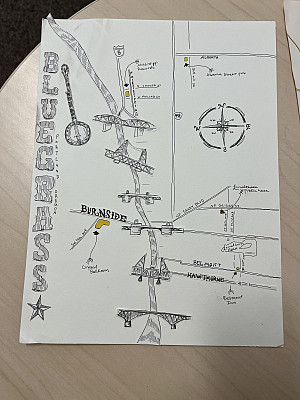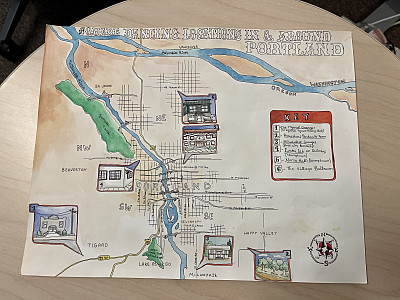Catching the Beat of Portland’s Music Scenes
Students in the Portland Music Scenes course connect directly with the city’s varied music communities—from country to jazz, punk to R&B, taiko to Irish trad—while learning to use the tools of ethnomusicology.
Immersive Learning



The 1990s cemented Portland’s reputation as a thriving music scene for indie rock, folk, and punk. A closer look reveals that the city’s musical culture is even richer than its reputation implies. With active communities in genres from jazz to hip-hop, shoegaze to taiko, Portland boasts not just one music scene, but many scenes.
Just ask students who have taken Portland Music Scenes, a 300-level course taught by Associate Professor of Music Kaley Mason. Engaging with the city and its residents is at the core of the class, which focuses on introducing students to the tools of ethnomusicology, or the historical study of music and culture. The class draws students from a wide variety of disciplines across campus, including music, sociology and anthropology, history, and rhetoric and media studies.
“Sometimes students are just curious,” says Mason. “They sign up for the course thinking it’s going to be a lecture-based course, but most are pleasantly surprised to learn that it’s a much more hands-on, workshop-oriented class. It’s really focused on learning directly from people in the music scenes around town.”
Mason started out studying music composition at Queen’s University in Kingston, Ontario, in Canada. A year abroad in Belfast, Northern Ireland, introduced him to ethnomusicology and anthropology. This chance encounter changed his life trajectory leading him to pursue a PhD in the field, with a research focus on South India.

Credit: Sabine Heier BA ’23 In the Portland Music Scenes class, students work on seven assignments, each focused on a different ethnographic skill. The culminating project involves a presentation that brings together the results of the various approaches. Students begin by developing a topic statement, a compelling idea that serves as a springboard for the project. They then immerse themselves in a Portland music community by attending performances, conducting interviews with scene participants, developing a photographic essay, and even creating a collaborative map that highlights key locations related to their “scene.”
For example, one of Mason’s former students focused their project on the culture of square dancing in Portland. Another student interacted with Portland Taiko, a nonprofit performance and education organization that “blends the tradition of Japanese taiko drumming with a sense of Asian American identity, creativity, and empowerment.”
A few years ago, one of Mason’s students decided to focus their project on the Portland punk scene and its intersection with the topic of aging.
“She included quotes from her interviews with people she met at local clubs,” says Mason. “She investigated how ageism might manifest in the Portland punk scene and asked, ‘What do punk scene members do to ensure their own inclusion?’ She interviewed a club owner about parenthood and managing responsibilities. Gender was a part of the conversation, too.”

Credit: Emily McClellan BA ’19 Other “scenes” that students have explored include bluegrass, folk, shoegaze (also known as dream pop), and R&B.
In addition to the students’ individual project work, Mason invites members of various Portland music scenes to visit the class. Guests discuss the community and their role in it. Then, as a group, the class visits a Portland venue or location that is related to the guest’s particular community in order to immerse themselves in the scene.
Yumi Torimaru, a recent addition to the music department’s faculty as instructor of shamisen, visited the class and spoke about her role in the local Japanese music scene. Torimaru, a performer and educator, is a multi-instrumentalist and accredited master of the tsugaru shamisen, a Japanese string instrument. She founded Takohachi, a nonprofit organization in Portland, dedicated to showcasing Japanese culture through music. The day after she visited, the class went into the city to watch her perform as part of the duo Maido Mind at the Portland Japanese Garden.
Tom O’Leary, owner of T. C. O’Leary’s A Little Irish Pub, also spoke to the class last month and the class attended a performance at the pub that same evening. Earlier in the semester, jazz guitarist Dan Balmer BA ’80, instructor of both jazz guitar and jazz combos, visited class and provided students with a history of the Portland jazz music scene.
“Afterward, we went to ‘The 1905,’ which is a prominent local jazz club, and heard him play,” says Mason. “It was the first time many of my students had been in a jazz club. It opened up a whole world to them and really connected them to Portland.”
Photo Essay
Engaging With Portland’s Music Scenes
Portland Music Scenes, a course taught by Associate Professor of Music Kaley Mason, allows our students to engage with the city and its residents while learning the tools of ethnomusicology. Students recently took a field trip to the Portland Japanese Garden, where students watched Yumi Torimaru, instructor in shamisen, perform as part of the duo Takohachi X.
More Stories

Sneaker Law
Stepping Into a New Era of Legal Education
Sports and entertainment attorney Nic Mayne teaches a new Sneaker Law course at Lewis & Clark Law School, providing hands-on contract drafting experience through the lens of the athletic footwear industry.

Climate Change
New Scholarship for International Environmental Law LLM Students
The Karuna Foundation recently funded a new scholarship for students from the Himalayan region. The scholarship—the first of its kind for the environmental program—will provide significant funding for an international student with a passion for environmental law and climate change mitigation.

Prosperous Portland
An L&C Leader for Portland’s Small Business Community
Lewis & Clark’s Entrepreneur in Residence Mitch Daugherty has been tapped to lead Portland’s newly created Office of Small Business, helping to connect small business owners with the resources they need to thrive.

Beyond Divisions
21st Annual Ray Warren Symposium Explores the Concept of Borders
This year’s Ray Warren Symposium on Race and Ethnic Studies, held November 13-15, is titled On the Border. It will examine the different borders we experience, the role of borders in our lives, and the relationship between borders and ideas of race and ethnicity.

